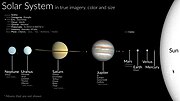 | Triton (moon) (redirect from Neptune I) hosts a thin but well-structured atmosphere. Triton orbits Neptune in a retrograde orbit—an orbit in the direction opposite to its planet's rotation—the... 78 KB (7,649 words) - 21:51, 23 April 2024 |
 | visit Neptune. After the Voyager flyby, NASA's next step in scientific exploration of the Neptune system was considered to be a flagship orbiter mission... 23 KB (2,496 words) - 10:34, 18 April 2024 |
 | discovery of the planet Neptune in 1846, there was considerable speculation that another planet might exist beyond its orbit. The search began in the... 75 KB (9,278 words) - 18:45, 26 March 2024 |
 | Pluto (redirect from Hadeocentric orbit) ring of bodies beyond the orbit of Neptune. It is the ninth-largest and tenth-most-massive known object to directly orbit the Sun. It is the largest... 162 KB (14,009 words) - 10:33, 19 April 2024 |
 | Solar System (section Galactic position and orbit) and Jupiter's orbit) and the Kuiper belt (just outside Neptune's orbit). Six planets, six dwarf planets, and other bodies have orbiting natural satellites... 206 KB (20,701 words) - 07:22, 1 May 2024 |
 | A hot Neptune or Hoptune is a type of giant planet with a mass similar to that of Uranus or Neptune orbiting close to its star, normally within less than... 7 KB (924 words) - 13:59, 18 April 2024 |
Laomedeia S/2002 N 5 History of Neptune Discovery of Neptune Exploration of Neptune Voyager 2 Interstellar Express Neptune Orbiter ODINUS Trident Outline of... 5 KB (359 words) - 15:17, 3 March 2024 |
 | a circumstellar disc in the outer Solar System, extending from the orbit of Neptune at 30 astronomical units (AU) to approximately 50 AU from the Sun.... 118 KB (13,221 words) - 02:57, 30 April 2024 |
 | Planet Nine (section Orbit) the peculiar clustering of orbits for a group of extreme trans-Neptunian objects (ETNOs), bodies beyond Neptune that orbit the Sun at distances averaging... 177 KB (18,857 words) - 08:11, 1 May 2024 |
trans-Neptunian objects that orbit in 2:3 mean-motion resonance with Neptune. This means that for every two orbits a plutino makes, Neptune orbits three times. The... 14 KB (980 words) - 09:54, 10 January 2024 |
Atmosphere Orbiter Mars Science Laboratory Giant planets: Jupiter Polar Orbiter with Probes (JPOP) Large satellites: Io Observer Ganymede Orbiter Neptune flyby... 16 KB (1,628 words) - 17:47, 8 January 2024 |
 | belt object (KBO) that orbits beyond Neptune and is not controlled by an orbital resonance with Neptune. Cubewanos have orbits with semi-major axes in... 23 KB (2,379 words) - 21:08, 17 April 2024 |
 | Proteus (moon) (redirect from Neptune VIII) Greek mythology. Proteus orbits Neptune in a nearly equatorial orbit at a distance of about 4.75 times the radius of Neptune's equator. Despite being a... 20 KB (1,814 words) - 07:04, 26 March 2024 |
 | Nereid (moon) (redirect from Neptune II) Nereid, or Neptune II, is the third-largest moon of Neptune. It has the most eccentric orbit of all known moons in the Solar System. It was the second... 16 KB (1,446 words) - 11:22, 19 April 2024 |
 | Haumea (section Possible resonance with Neptune) (minor-planet designation: 136108 Haumea) is a dwarf planet located beyond Neptune's orbit. It was discovered in 2004 by a team headed by Mike Brown of Caltech... 82 KB (7,666 words) - 23:29, 25 April 2024 |
 | Planet (redirect from Planetocentric orbit) Venus, Earth, and Mars, and the giant planets Jupiter, Saturn, Uranus, and Neptune. The word planet probably comes from the Greek planḗtai, meaning "wanderers"... 195 KB (20,575 words) - 05:22, 26 April 2024 |
S/2021 N 1 (category Moons of Neptune) Telescope at Mauna Kea, Hawaii, and later announced on 23 February 2024. It orbits Neptune in the retrograde direction at an average distance of over 50 million km... 18 KB (1,751 words) - 08:46, 21 March 2024 |
 | Neso (moon) (redirect from Neptune XIII) Neso /ˈniːsoʊ/, also known as Neptune XIII, is the second-outermost known natural satellite of Neptune, after S/2021 N 1. It is a retrograde irregular... 9 KB (587 words) - 17:01, 29 April 2024 |
Clearing the neighbourhood (redirect from Orbit neighborhood) as a dwarf planet. This includes Pluto, whose orbit intersects with Neptune's orbit and shares its orbital neighbourhood with many Kuiper belt objects.... 21 KB (3,184 words) - 17:36, 27 April 2024 |










